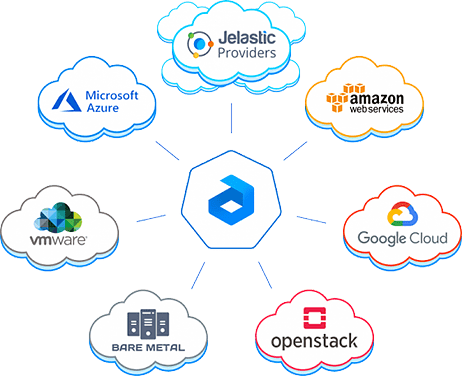Multi-Cloud Interoperability != Cloud Services Aggregation
Multi-cloud is defined as an approach that combines more than one cloud (public or private), from more than a single cloud vendor. However, this is not an aggregation of various services from different vendors, it requires a mandatory glue – cloud-agnostic approach with interoperability across all providers. Below we’ll cover what problems the right multi-cloud implementation can solve, what challenges can be faced, and how to achieve the required interoperability.
Problems Multi-Cloud Solves
Usually, we are not sure what solution is better, but we are perfectly aware of the problems we are struggling with. Below are some of them that can be solved with the multi-cloud approach:
Lock-In
The cloud strategy started years ago in most cases already do not meet the current requirements of the enterprise company – the product line changed, new technologies arose, the load and number of users grew, etc. Soon you understand that there are lots of new solutions and services at the market that can ease and improve the DevOps processes thus pushing the results higher and TCO lower. But, at the same time, the whole project architecture is built keeping in mind the features of the previously chosen cloud platform, so migration becomes next to impossible and the company is just stuck to a vendor.
And if the projects are built based on a multi-cloud approach, you get compatibility to different vendors by default and can move your applications anytime to the most appropriate vendor.
Cost
Production environments require the highest performing capacities, so you choose the most appropriate cloud option and most likely it will be pretty expensive. But before getting to the production, the project goes through the whole lifecycle of development, testing, and staging. As a result, you pay high rates on all stages.
Multi-cloud provides the ability to mix and match pricing plans for infrastructure from different vendors to meet not only technology needs but also available budgets. In most cases, dev and stage workloads can be placed on less expensive cloud capacities, while production environments will go to a premium, and thus high-priced, cloud. Also, various types of data can be distributed to the generic public or more secure and isolated private cloud.
Latency
Modern business more and more erases the geographical boundaries letting target world-wide audience. But this leads to new challenges, as the clients demand quality and fast performance no matter where they are located. Bringing the connectivity point closer to customers ensures lower latency. That’s where multi-cloud availability can assist, as the data can be distributed across regions from geographically disparate locations. Each service provider cannot build data centers in all required locations, but using multi-cloud management solutions companies get a wider choice of infrastructure from other vendors smoothly integrated within the same platform.
Availability
Even reliable cloud giants can fail and face outage, especially due to some weather circumstances, human errors or other unexpected factors. That’s why “putting all your eggs into one basket” has always been a mistake. The workloads distribution across different clouds improves not only latency but also availability and performance. And utilizing redundancy in infrastructure and software guarantees a higher level of fault tolerance. This is a classic approach to mitigate the risk of application outages, downtime, and data loss.
Security and Regulation Laws
Many countries introduce very specific regulations considering data storing requiring to keep it inside the country. And recently evolved GDPR in Europe only reminded how dependent we are when it comes to regulations and security laws. In other cases, such rules are dictated by the security requirements of the company itself. As a result, businesses are looking for a possibility to distribute the data across locations or various types of clouds and, at the same time, be compliant with different regulation laws.
Multi-Cloud Challenges and Their Solutions
Moving to a multi-cloud requires thorough preparation, smart coordination of people and resources, as well as patience and positive thinking. Let’s look deeper at some of the challenges and consider the ways to overcome them.
Cloud Expertise Gap while Migrating to Multi-Cloud
Extending the number of cloud environments usually leads to extending the skills, tools, and efforts required to run these environments effectively. Choosing the cloud options should take into consideration the opinion of cloud experts who know the strengths and weaknesses of the available offerings and the way they interrelate with the specific needs of the company.
Multi-cloud integration can involve tasks unfamiliar even to experienced technical employees. So before starting the movement, an organization should be ready to make investments in order to get the needed skill sets internally, or partner with a managed service provider that has a proven track record of multi-cloud expertise.
The process of moving workloads from one cloud model to the other is not that trivial. And many companies struggle with how to ensure that the result will match expectations but not just waste so valuable resources.
The right multi-cloud management tool can ease and automate the deployment of existing standards and policies across the new cloud network. But such cloud platform should also be chosen taking into consideration upcoming company’s plans to eliminate the problem of vendor lock-in in the future. Zero code change, no proprietary API, standard container packaging support, ability to migrate legacy applications – these are just some of the aspects that should be considered.
Management Complexity
Running several clouds requires not only skills but human and time resources. Even seemingly simple things as resource provisioning can be tangled if vendors use various methods or measures. Each of them has its own portals, APIs and processes that should be managed.
DevOps experts who can work across multiple cloud platforms are difficult to find. So a possible solution here can be to choose the right platform that provides automation and unified management of public and private clouds within a single panel. This can help to achieve interoperability unifying application deployment and lifecycle management within different vendors and enabling easy migration across them.
Companies should omit cases that lead to significant reconfiguration or cloud-specific adaptation of applications, as well as a mismatch of features. If the application requires different cloud-specific APIs or services on various clouds, their deployment or migration across platforms needs immense work each time, then it loses the multi-cloud meaning and leads to waste of efficiency. In order to avoid unnecessary complexity, it is important to follow standardization in tools and processes such as deployment and scalability, as well as avoid using any proprietary services that are not available at other cloud providers.
Security Concerns
Multiple cloud platforms open a wider choice of possible attacks and vulnerabilities and thus require extra efforts to gain effective security, governance, and compliance.
The security is not entirely the responsibility of the vendors involved in the multi-cloud strategy of the organization. Of course, they should provide a set of tools and top-rank approaches, but still, the main responsibility remains on the company itself.
It’s vital to thoroughly discuss security requirements with the potential cloud vendor before signing SLA to find out what is going to be covered by the provider and what reaction to the security breach or data loss should be expected.
Cost Tracking
Cost flexibility is one of the main benefits of a multi-cloud approach, but at the same time, cloud diversity can lead to extra risks and loss of control over the budgeting. Oversight, lack of ROI analysis and tracking of cloud consumption can grow into a big waste.
In order to ensure multi-cloud efficiency, the organization has to continuously monitor the cloud spends, tune them in accordance with the projects and work of the team, as well as be proactive predicting the future consumption patterns.
In some cases, taming multi-cloud economics can be considered as the biggest challenge. Every platform has its own billing system, pricing model, resizing and payment options so optimization and consolidation of the whole budgeting can become a total nightmare. That’s why this requires either internal team (e.g. cloud cost analyst, engineers for tuning) or partnership with a managed multi-cloud provider that can consolidate the data and provide cost analysis for specific applications separately and the organization in general.
Redundancy Strategy
Building the strategy for application and data redundancy, backups, disaster recovery, and failover protection cannot be overrated, especially if the systems are located in the external data center, and you cannot fix the issues directly in case of an outage or other emergencies.
The system should include the possibility for automatic switching to the backup platform in case of failed operability or full non-availability of the primary cloud. This can be achieved by redirecting user requests from one cloud to another. Also, there is a set of software that can be integrated to automatically make the switch based on the outage trigger.
In order to ensure that data won’t be lost while switching from one cloud to another, it is required to think through the process of data synchronization between every instance or application replica across multi-cloud implementation. The updates to the database between clouds should be performed with the lowest latency possible to avoid data loss during the transfer. Besides, several times per year IT departments have to check the failover process emulating the errors (even if they seem impossible) and making sure that all environments work as intended in all cloud installations.
Compliance with Data Regulations
While choosing vendors for your multi-cloud infrastructure, it is important to consider the policies and regulations of your company, country where you plan to locate workloads, and the provider itself.
Some local governments restrict data storing, so you cannot place it outside the country. Also, different organizations like financial or governmental institutions can host their sensitive workloads only in highly secure private clouds. All such specifics should be considered before involving the vendor in your multi-cloud strategy.
Summary
The key ingredient of a solid multi-cloud strategy is the abstraction. Organizations need a governance layer which can provide this complete abstraction from the unique functionality of different cloud vendors and enable cloud-agnostic implementation without extra complexity. Such converging point between the company and clouds should be either aware of all cloud specifics, or combine standardized services from the required clouds and provide missing functionality based on the company needs. Multi-cloud management platforms like Jelastic provide the required level of interoperability to ease the entry point and eliminate complicated processes throughout the project lifecycle.
| Published on Java Code Geeks with permission by Tetiana Fydorenchyk, partner at our JCG program. See the original article here: Multi-Cloud Interoperability != Cloud Services Aggregation Opinions expressed by Java Code Geeks contributors are their own. |







